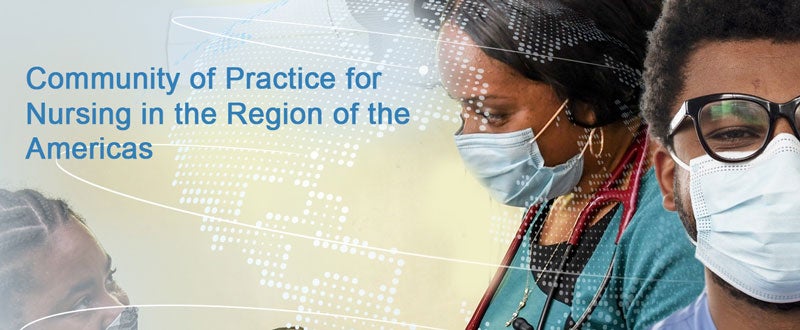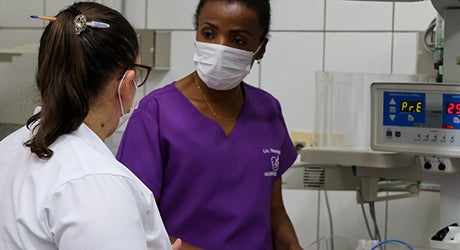Introduction
Nurses and midwives are key actors in health promotion and disease prevention. They are the backbone of healthcare systems worldwide, working on the front lines of disease prevention, health promotion, and health management.
Despite their essential role in health care, there is a shortage of professionals in the Region of the Americas that affects the delivery of care.
The nursing and midwifery workforce is key to responding to health emergencies and building resilient health systems. Investments are needed in education, employment, leadership, and service delivery.
- There are approximately 27.9 million nursing professionals in the world. About 30% are in the Americas. 1
- Nurses represent 56% of the total health workforce in the Americas. 1
- An estimated 1.6 million nursing and midwifery professionals are needed in the Region of the Americas to meet the needs of the entire population in health care, health promotion, and disease prevention. 2
- Midwives can meet nearly 90% of the need for essential interventions in sexual, reproductive, maternal, newborn, and adolescent health, bringing safe and effective care within reach of more people. 3
- Nursing education systems are dissimilar in terms of the competencies of trained professionals, the structure and updating of the curriculum, and faculty qualifications. 4
- Interprofessional education remains under-explored and under-adopted in nursing education programs. 5
- All countries in the Region of the Americas regulate the nursing profession through a regulatory body. The United States, Canada, and most Caribbean countries require competency exams for initial registration, and in 54.3% of the countries, renewal of registration is required. 6
- In the Americas, 92% of countries have legislation that recognizes midwifery as a profession distinct from nursing. 3
- Expanded roles develop new competencies and a new training model, opens other practice scenarios, and promotes autonomy, collaboration, and social and economic recognition. In most of Latin America and the Caribbean, advanced practice nursing (APN) is in the early stages of development. 7
- In the health sector, women represent the majority of nursing and midwifery professionals in the Region; however, they are underrepresented in leadership positions and face inequalities in salary levels. 8
:: Sources
- World Health Organization (2020). State of the world's nursing 2020: investing in education, jobs and leadership.
- Murray, C. J. L., & Lopez, A. D. (2017). Measuring global health: motivation and evolution of the Global Burden of Disease Study The Lancet, 390(10100), 1460-1464.
- United Nations Population Fund, World Health Organization, & International Confederation of Midwives (2021). The State of the World's Midwifery 2021.
- Cassiani SHDB, Wilson LL, Mikael S de SE, Peña LM, Grajales RAZ, McCreary LL et al. The situation of nursing education in Latin America and the Caribbean towards universal health. Rev Lat Am Enfermagem 2017;25:e2913. doi:10.1590/1518-8345.2232.2913.
- Fortuna CM, Dias BM, Laus AM, Mishima SM, Cassiani SHDB. Educación interprofesional en salud en la Región de las Américas desde la perspectiva de la enfermería. Revista Panamericana de Salud Pública 2022;46:1. doi:10.26633/RPSP.2022.69.
- Cassiani SHB, Lecorps K, Rojas Cañaveral LK, Da Silva FAM, Fitzgerald J. Regulation of nursing practice in the Region of the Americas. Rev Panam Public Health. 2020;44:e93. doi.org/10.26633/RPSP.2020.93.
- Pan American Health Organization. The Strategic Importance of National Investment in Nursing Professionals in the Region of the Americas. Washington, D.C., PAHO, 7 (https://iris.paho.org/handle/2022.2/55957).
- Fitzgerald J, Schutt-Aine J, Houghton N, De Bortoli Cassiani SH, Báscolo E, Alarcón G et al. The Importance of a Gender Focus in Building Resilient, Equitable, and Universal Health Systems. Revista Panamericana de Salud Pública 8;2023. doi:47:1/RPSP.2023.135.
- Nursing and midwifery education varies widely from country to country. The lack of faculty with advanced training and the poor distribution of undergraduate and graduate programs are an obstacle to the adequate training of nursing and midwifery personnel.
- Transformative training programs based on competency-based education, interprofessional education, and the appropriate use of technology, are essential when training the nursing and midwifery workforce.
- There is a pressing shortage of nursing and midwifery personnel and difficulties persist in recruiting new professionals and retaining those already working. This shortage has negative effects on health outcomes and hinders the delivery of primary care.
- Increased pay and improved working conditions are necessary to promote the development and retention of nursing and midwifery personnel. Also, incentives must be given -- including career development pathways and continuing education opportunities -- to promote professional development and workforce retention.
- Reviewing and reorganizing the scope of practices performed by nursing and midwifery personnel is essential to optimizing task-sharing.
- It is crucial to put in place a monitoring system that defines and standardizes roles and responsibilities, regulates the scope of functions, and establishes the financial investments needed to increase the number of nursing and midwifery professionals working in primary care and retain them.
- Nursing and midwifery professionals interact directly with individuals and communities, establishing trusting relationships. They are involved at all levels of health care delivery and can be decisive leaders in the transformation of health systems. It is therefore essential to promote leadership opportunities and develop the capacities of nursing professionals.
The strategic lines of the Policy on the Health Workforce 2030: strengthening human resources for health to achieve resilient health systems seeks to strengthen governance and promote national human resources for health policies and plans; develop and consolidate regulatory mechanisms related to human resources for health; strengthen the formation and integration of interprofessional teams; enhance workforce capacity-building; promote decent working conditions and the physical and mental protection of health care workers.
The documents Strategic Directions for Nursing in the Region of the Americas and The Strategic Importance of National Investment in Nursing Professionals in the Region of the Americas suggest actions and strategies to strengthen the nursing workforce in primary health care services through investment in education, employment, leadership, and service delivery.









